The Barbarian and the Geisha
5.8 /10 1 Votes
3/5 Blu-ray Music director Hugo Friedhofer Duration Language English | 5.5/10 IMDb Country United States | |||||||||||||||||||||||||||||||||
 | ||||||||||||||||||||||||||||||||||
Release date September 30, 1958 (1958-09-30) (U.S.) Cast Similar movies Ginza Cosmetics , Late Chrysanthemums , Wife! Be Like a Rose! , Memoirs of a Geisha , In the Realm of the Senses , Tokyo Godfathers Tagline The geisha girl they sent to love and to destroy the barbarian from the west! | ||||||||||||||||||||||||||||||||||
On the eve of the Meiji Restoration, Japan is still a nation thoroughly mistrustful of Western influence. The U.S. government dispatches Townsend Harris (John Wayne) to the port village of Shimoda to serve as U.S. consul to Japan. There Harris and his interpreter, Henry Heusken (Sam Jaffe), meet resistance from the locals, who refuse to recognize his diplomatic status. Eventually Harris meets lovely geisha Okichi (Eiko Ando), who helps him bridge the cultural divide.
Contents
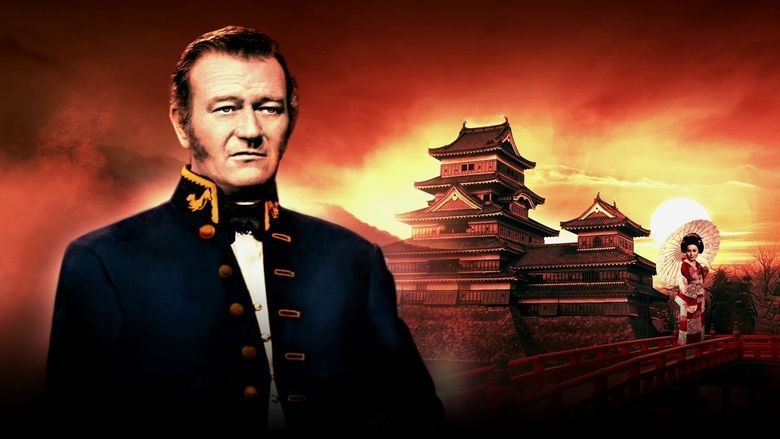
The Barbarian and the Geisha is a 1958 film starring John Wayne, Sam Jaffe and Japanese actress Eiko Ando set in 1850s Japan. Shot primarily on location in Japan, it was directed by John Huston.
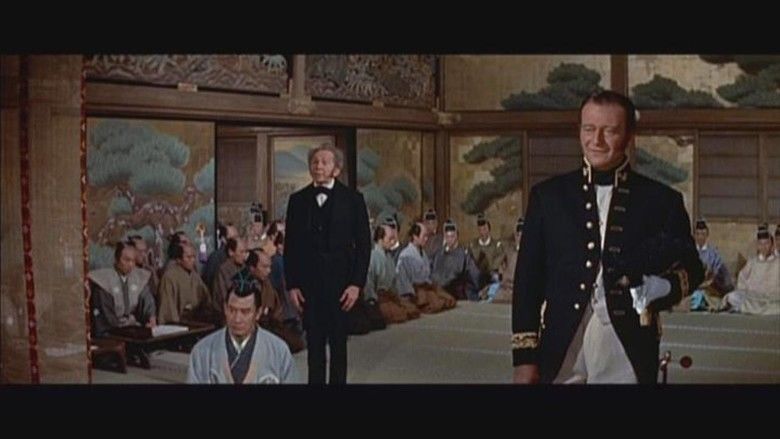
Townsend Harris is sent by President Pierce to Japan to serve as the first U.S. Consul-General to that country. Harris discovers enormous hostility to foreigners, as well as the love of a young geisha.
Plot

In 1856, Townsend Harris (John Wayne) is sent by President Pierce to serve as the first U.S. Consul-General to Japan, following the treaty written by Commodore Matthew Perry. Accompanied only by his translator-secretary, Huesken (Jaffe), comes ashore at the town of Shimoda, as specified in the treaty as the location for an American consulate.
However, Japanese governor (So Yamamura) refuses to accept his credentials, denying him any official status, due to a conflict between interpretations of the treaty terms. While Harris believes that the Consul shall be present whenever either country requires, the Japanese believe the terms to permit a consul only when both countries require. The governor holds to his interpretation, largely because of objections over the threats under which the treaty was forced upon them. Harris is permitted to remain in Shimoda, but only as a private citizen, with no recognition of his official status. He is provided the use of an abandoned home, adjacent to the town cemetery.
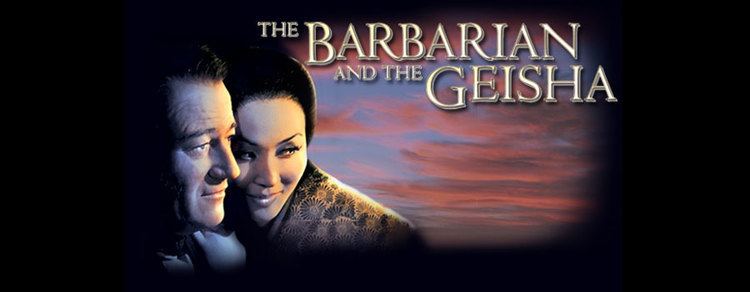
The governor explains that, in the two years following Perrys visit, various natural disasters had taken place. Some Japanese believed them to be warnings from the gods to avoid foreign influences. In the weeks that follow, Harris is the target of distrust and hostility, to the extent that Tamura orders townspeople to not even sell him food. Some in Japan wanted the country opened, but many others feared the corruption of foreign influences, and invasion by the barbarians of other lands. For this reason, Harris is not permitted to leave Shimoda, nor to go any closer to the capitol in Edo, 100 miles away.
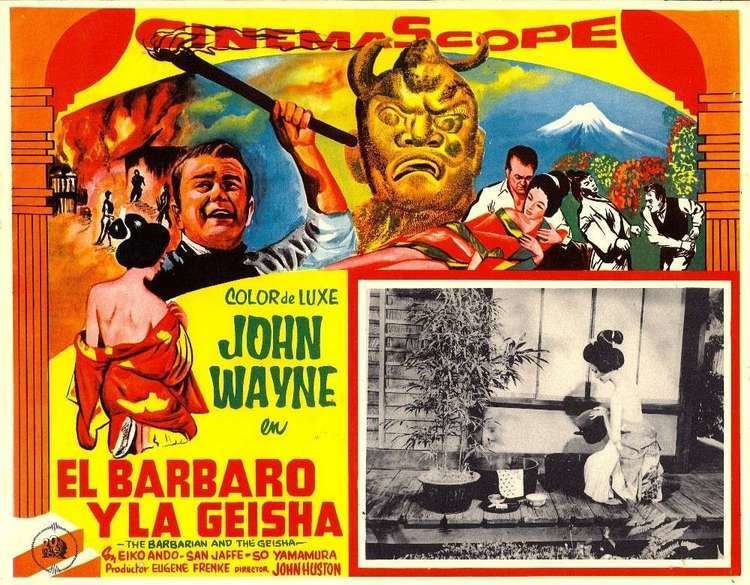
For his own part, Harris does his best to cooperate with the Governor, even obeying orders to take down the American flag which had been raised to mark the location of the Consulate. His cooperation noted, after several months, Harris is eventually invited to dine with the Governor, a dinner following which Tamura sends a geisha named Okichi (Eiko Ando) to take care of Harris needs.
The relationship between Harris and Okichi grows closer and more intimate, and she helps him understand Japanese culture.
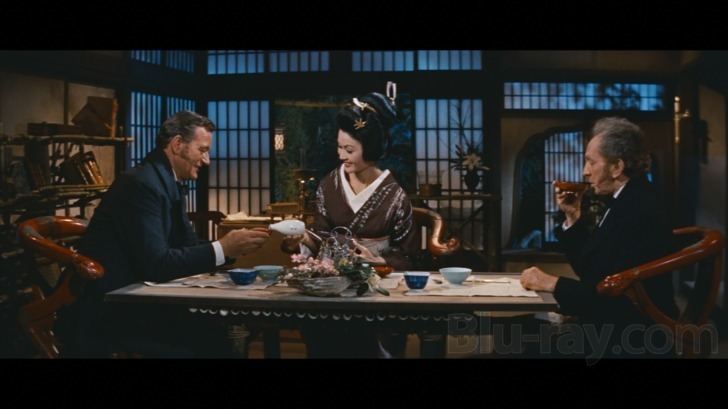
Harris makes a number of blunders, one of which leads to a cholera epidemic and the destruction of the town. However, out of this disaster comes Harris opportunity to go to Edo, where he must then convince the Shogunate to open the country, while facing his greatest crisis.
Cast
Production

Director Anthony Mann initially owned the story but he sold the rights to 20th Century Fox after being unable to sign a big star to play the lead.
Exteriors were shot on location in Japan at Kyoto and the Todai-ji shrine in Nara. Interiors and additional scenes were completed at Toho Studios in Tokyo and 20th Century Fox Studios, Los Angeles. During filming, Wayne and director John Huston did not get along; in one altercation, Wayne throttled and punched Huston on set.
The film was heavily re-edited by 20th Century Fox before release. Director John Huston denounced this version and even wanted to have his name removed from the credits. Huston had wanted to make a particularly Japanese film in terms of photography, pacing, color and narration but according to him only a few edits – representing his vision – were left intact in the theatrical version.
Reception
The film performed disappointingly at the box office. Despite Hustons anger at studio interference, the New York Times liked the films cinematography calling it a "whole picture out of patience and pageantry."
It was released on Blu-ray Disc and DVD in 2012.
Historical background
The film is based on American diplomat Townsend Harris and his time in Japan during the final years of the Tokugawa shogunate. President Franklin Pierce named Harris the first Consul General to the Empire of Japan in July 1856. He opened the first U.S. Consulate at the Gyokusen-ji Temple in the city of Shimoda, Shizuoka Prefecture. This consolidated the mission by Commodore Perry who established the first trade agreement between the U.S. and Japan in 1853. Harris left Japan in 1861.
In Harris time, Japan was living through the final years of its period when the country remained in international isolation and adhered to strict customs and regulations intended to promote stability. In 1868, just seven years after Harris departure, the Meiji Restoration started Japans emergence as a modernized nation in the early twentieth century through massive industrialization, and enormous reforms to its political and social structure.
The film incorporates the enduring Japanese tale about Harris and a 17-year-old geisha (named Okichi ()). The story says she was pressured by Japanese authorities into forming a relationship with Harris to make the trade meetings go better. However after Harris departed from Japan, she was called the "Barbarian Okichi" and ostracized by Japanese people; she began drinking and eventually committed suicide in 1892. But according to historians, most of the story is not true. Although Okichi was a real person, she was merely one of Harris housekeepers, and he apparently fired her after only three days of work.
Bibliography
References
The Barbarian and the Geisha WikipediaThe Barbarian and the Geisha IMDbThe Barbarian and the Geisha Blu-ray.comThe Barbarian and the Geisha themoviedb.org
